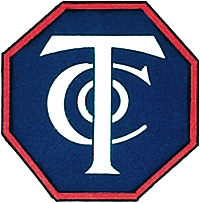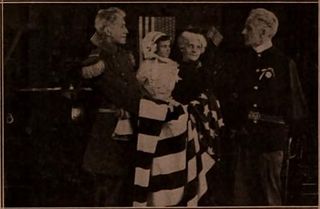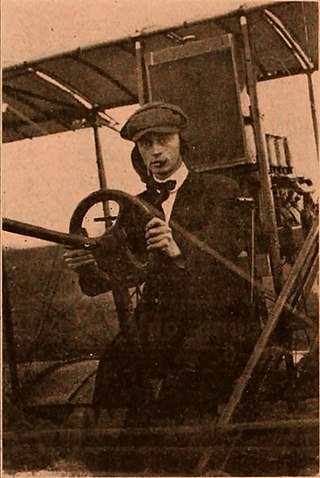
Edwin Thanhouser was an American actor, businessman, and film producer. He was most notable as a founder of the Thanhouser Company, which was one of the first motion picture studios. His wife Gertrude Thanhouser and brother-in-law Lloyd Lonergan were co-founders.

The Thanhouser Company was one of the first motion picture studios, founded in 1909 by Edwin Thanhouser, his wife Gertrude and his brother-in-law Lloyd Lonergan. It operated in New York City until 1920, producing over a thousand films.

Baseball and Bloomers, also known as Baseball in Bloomers, is a 1911 American silent short sports film produced by the Thanhouser Company. The film stars William Garwood and is the debut of Marguerite Snow. The film focuses on a female seminary which organizes a baseball club and challenges another school to a game. The boys accept to the game with amusement and find that the women are not good at baseball. Two Harvard University baseball stars join the ranks of the girls in disguise and defeat the boys team. The script may have been written by Lloyd Lonergan and the film may have been directed by Barry O'Neil or Lucius J. Henderson. The film was released on January 6, 1911 and it received positive reviews. The film is presumed lost.

Gertrude Homan Thanhouser, wife of co-founder Edwin Thanhouser, worked at the Thanhouser Company film studio as actress, scenario writer, film editor, and studio executive. Her efforts made the studio one of the key independent US film studios in the nickelodeon and transitional era, praised for its erudite adaptations of Shakespeare and other "classical" stage dramas to the screen.

St. Elmo is a 1910 American silent short drama produced by the Thanhouser Company. The scenario was adapted by Lloyd Lonergan from Augusta Jane Evans's 1866 novel of the same name. Frank H. Crane and Anna Rosemond play the leading roles in the simplified plot that was reliant on inter-titles to tell the story. The film follows St. Elmo who is engaged to his cousin Agnes, being betrayed by his friend Dick Hammond who has an affair with Agnes. St. Elmo challenges and kills Hammond in a duel. A young girl, Edna witnesses the duel and leads Agnes and the sheriff off the trail. St. Elmo disappears and returns five years later to woo Edna. She rejects then accepts his affections only to stop him from committing suicide. The production was met with mixed reviews by critics, but was successful. The film is presumed lost.

She's Done it Again is a 1910 American silent short comedy written by Lloyd Lonergan and produced by the Thanhouser Company in New Rochelle, New York. A thief named Sikes decides to rob a society woman who falsely claimed to have been robbed when she in fact pawned her jewelry. A gentleman thief strikes and robs her, but no one believes her. The thief is caught only by a clever detective. The film was the third release of the Thanhouser company and featured the leading players, Anna Rosemond and Frank H. Crane. The film was met with positive reviews, but is presumed to be lost.

Daddy's Double is a 1910 American silent short drama produced by the Thanhouser Film Corporation. The film focuses on Hal, a young man, who proposes to Sue, his love interest. Her father overhears and becomes furious before whisking his daughter away to a boarding school. Hal and Sue attempt to elope, but it is foiled. Hal then gets an idea to disguise himself as the father and reclaim Sue. The plan works, but the father follows in pursuit. He breaks into the wedding ceremony at the parson's house and sees his double. He then laughs and approves of the marriage. The film was the fourth release by Thanhouser and it was met with favorable reviews by critics. In 2007, a surviving print was released on DVD with a new original score composed and performed by Raymond A. Brubacher.

She Wanted to Marry a Hero is a 1910 American silent short drama produced by the Thanhouser Company. Elsie Plush, an avid dime novel reader, came to idolize the concept of a hero and rejected her plain boyfriend, George Mild. She idolizes a series of men, only to have each ideal candidate be shattered a short time later by a series of incidents which highlight their flaws or weaknesses. In the end, Elsie returns and accepts her boyfriend's marriage proposal. Released on April 29, 1910, as split-reel with The Cigars His Wife Brought, the film was given favorable reviews and had advertisements for its showing until late 1912. The film is presumed lost.

Jane Eyre is a 1910 American silent short classic drama produced by the Thanhouser Film Corporation. Adapted from Charlotte Brontë's 1847 novel, Jane Eyre, the film mirrors the events and plot of the original book. The writer of the scenario is unknown, but Lloyd Lonergan probably adapted the work. The film's director is often and erroneously claimed to be Theodore Marston, but Barry O'Neil or Lloyd B. Carleton are possible candidates. The cast of the film was credited, an act rare and unusual in the era.
Cupid at the Circus is a 1910 American silent short drama produced by the Thanhouser Company. The film is a romance with a storyline focused around a country boy who follows a circus parade to the circus grounds and becomes intent on sneaking into the show. He is discovered, but before he can be ejected, a girl asks her father to buy him a ticket of admission. Thankful, the boy gives her his pocket knife. Years later the two meet again and when he sees her using his pocket knife. He proposes and she accepts. Not too much is known for certain about the production of this film, including the writer, director and photographer credits. The circus scenes were done with special arrangement by Barnum & Bailey. The film was released on May 20, 1910, to favorable reviews. The film is presumed lost.

The Writing on the Wall is a 1910 American silent short drama produced by the Thanhouser Company. Directed by Barry O'Neil from a script by Lloyd Lonergan, this presumed lost film focuses on a young girl named Grace who becomes attracted to a wealthy man named Jack. Two men, named Turner and Hank plot to rob Jack after he withdraws a large sum of money from a bank, but Grace warns him of a plot to drug him. Jack escapes and marries Grace. The film has no known trade publication reviews, but reviews may exist for this film. Theaters were advertising this film as late as 1913.

The Woman Hater is a 1910 American silent short drama produced by the Thanhouser Company. The film focuses on Tom Taylor, a woman-hater, who sells his property to a financier at a play. In order to finalize the transaction, Taylor must go to the financier's hotel and becomes the subject of a bet by Lou Bennett that she can win his affections. Lou succeeds in the bet, but Taylor finds out and is preparing to leave forever when Lou speaks to him. Little is known about the production or the cast other than a single credit of Violet Heming as Lou Bennett. The film was released on June 14, 1910, but is not known to have been reviewed by any trade publications. The film is presumed lost, but another production of the same name released the same year was rediscovered in New Zealand in 2010.

The Little Hero of Holland is a 1910 American silent short drama produced by the Thanhouser Company. It is an adaptation of the short fictional story popularized in Hans Brinker, or The Silver Skates, about a boy who plugs a leaking dike with his finger to prevent it from bursting. The role of the boy was played by Marie Eline, but little else is known about the production and cast of the film. The director may have been Barry O'Neil and the writer may have been Lloyd Lonergan. Parts of the film were shot on Glen Park Island in New Rochelle, New York. The film was released on June 17, 1910 and saw a wide release, including the United Kingdom. The film is presumed lost.

The Flag of His Country is a 1910 American silent short drama film produced by the Thanhouser Company. The patriotic film focuses on a man aptly named Walter North who sides with the Union and whilst his wife sides with the Confederacy in the American Civil War. The family is reunited thirty years later at a Grand Army of the Republic reunion through the actions of their grandchild. Little is known about the production and cast of the film, but the role of granddaughter was played by Marie Eline. Released on July 1, 1910, the film took place within living memory of the war and a reviewer in The Moving Picture World noted that the film would not offend its audience members. The film is presumed lost.

The Girl Strike Leader is a 1910 American silent short drama produced by the Thanhouser Company. The film deals with labor relations when Hal Stephens disguises himself and works in a factory he was given by his father. As a laborer, he falls in love with a young working girl named Lou and protects her against a manager. Lou leads a strike when wages are ordered to be cut by 10%, but the strikers return to work on the verge of starvation. Lou, who resists, is saved by Hal who assumes control, restores the wages and removes the previous manager.

The Wild Flower and the Rose is a 1910 American silent short drama produced by the Thanhouser Company. The film focuses on Frank Wilson, the son of an inventor who has constructed a new airplane model. After failing to secure financing, his father suggests that he marry Rose, the daughter of his wealthy employer, to get the money they need. Jack rejects this idea because he is engaged to another woman, but he soon learns she does not love him. He heads out West to seek a fortune and is quickly successful. He returns to the aviation field and meets Rose again, after a successful flight she confesses to loving him. The cast and staff credits are unknown, but the film may have included scenes from the 1910 International Aviation Meet at Belmont Park. One reviewer claimed that a Wright brothers flyer was also shown in full flight. The film was released on November 25, 1910, but is now presumed lost.

The Childhood Of Jack Harkaway is a 1910 American silent short drama produced by the Thanhouser Company. Adapted from Bracebridge Hemyng's Jack Harkaway story series by Lloyd Lonergan, the film depicts the life of the title character. Given to the care of strangers after his birth, Jack grows up and is sent to a school at age 12. After being severely and unjustly punished by the schoolmaster, Jack runs away and comes across two thieves plotting a robbery. Jack hurries to the house and warns the mistress of the planned robbery. The robbery is foiled and the lady of the house is very grateful, but Jack's schoolmaster and his guardian arrive to take him back. She recognizes the guardian as the man who forced her to turn over Jack and turns them out of the house. The film's cast and production credits are unknown. The film was released on December 23, 1910, it was met with favorable reviews and saw a wide national release. In 1988, a severely deteriorated nitrate print of the film was known to exist and it was likely transferred to the Library of Congress archives in 1997.

Hypnotized, released in Britain as A Quack Hypnotist, is a 1910 American silent short drama produced by the Thanhouser Company. The film focuses on May Smalley and Jack, who loves her, who attend a traveling show that comes to their little town. The show consists of a hypnotist and a Hindu magician and proves to be a popular show, but the hypnotist who is becomes interest in May. The hypnotist lures May away by telling her that he has a message for her from the spirit world and later gets her to leave town with him. Jack knocks the magician down and takes his costume and follows the hypnotist and May back to their hotel, where he rescues her. Aside from William Russell's role in the film, the production and cast credits are unknown. The film was released on December 30, 1910, it was met with positive reviews. The film is presumed lost.

The Heart of Ezra Greer is a 1917 American silent drama film produced by the Thanhouser Company and directed by Emile Chautard. The film focuses on Ezra Greer, a successful middle-aged man who searches for his college age daughter, Mary. The wayward Mary was romanced and abandoned by Jack Denbeigh, later bearing his child. Once Ezra becomes broke he finds employment as the valet for Jack Denbeigh. After Jack's engagement to a cabaret girl, Mary becomes upset and leaves her child at Jack's home. Contrary to Jack's wishes, Ezra keeps the child and Jack ultimately reveals that the child is his own. Ezra convinces Jack to make things right and Ezra convinces the cabaret girl to leave Jack. After a carriage accident in which the baby is injured, Ezra and Jack rush to the hospital and find Mary as a nurse crying over the child. The film ends with the marriage of Jack and Mary. The film was released by Pathé on October 7, 1917. The film was the final release from Thanhouser and was deemed to be an average film by most reviewers. Criticism for the film hinged on far-fetched coincidences to drive the plot. The film is presumed lost.
Under False Colors is a 1917 American silent drama film produced by the Thanhouser Company and directed by Emile Chautard.
















